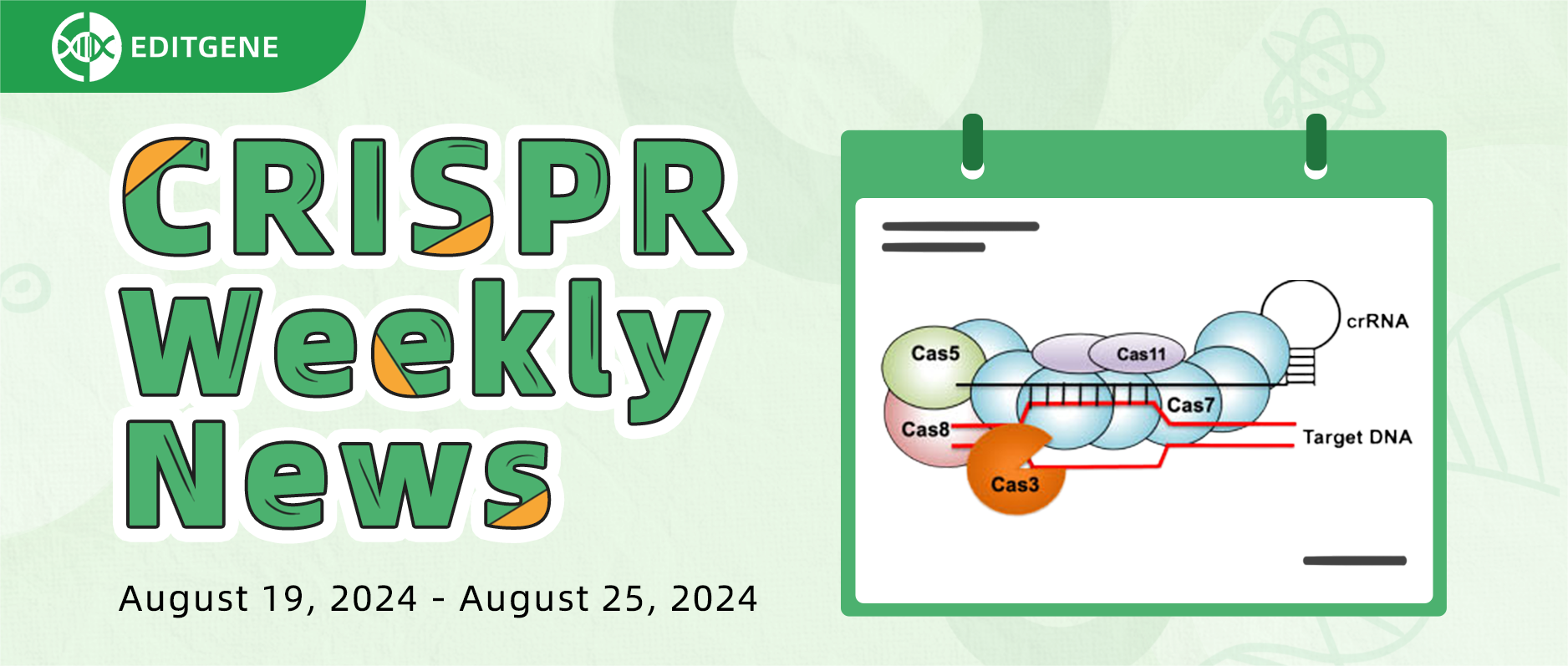[Weekly News] New Breakthrough in Cas Enzyme Structure: The First Structure of Type I-C NlaCas3 Enzyme Revealed!
CRISPR/Cas9

The CRISPR/Cas system is a revolutionary technology in the field of modern biological sciences, with applications expanding into medicine, agriculture, ecological conservation, and more, continuously producing new achievements and applications. "CRISPR Tales" features a weekly news column to bring you the latest research and industry news about CRISPR. Here is a brief overview of the past week's news:
I. Research News
1. Article Title: CRISPR screen of venetoclax response-associated genes identifies transcription factor ZNF740 as a key functional regulator
Journal: Cell Death & Disease (IF: 8.1)
Original Article Link: https://doi.org/10.1038/s41419-024-06995-x
Venetoclax and other BCL-2 inhibitors show therapeutic promise in Acute Myeloid Leukemia (AML) and other cancers, but resistance to these drugs poses a significant challenge. Thus, understanding the mechanisms that regulate venetoclax response is crucial.
Recently, researchers from the University of Alabama at Birmingham conducted a CRISPR knockout screen aimed at exploring the functional roles of genes associated with clinical sensitivity to venetoclax.
The study revealed that the transcription factor ZNF740 plays a key role in determining the sensitivity of AML cells to the BCL-2 inhibitor venetoclax. The research highlights the regulatory role of ZNF740 on the pro-apoptotic protein NOXA, which affects the stability of MCL-1, a key factor in venetoclax resistance.
2. Article Title: CRISPR Screening of Transcribed Super-Enhancers Identifies Drivers of Triple-Negative Breast Cancer Progression
Journal: Cancer Research (IF: 12.5)
Original Article Link: https://doi.org/10.1158/0008-5472.CAN-23-3995
Triple-negative breast cancer (TNBC) is one of the most challenging forms of breast cancer to treat due to the lack of targeted therapeutic options. Systematic analysis of regulatory elements beyond protein-coding genes can uncover pathways for therapeutic intervention.
Researchers in the United States employed high-throughput CRISPR screening technology coupled with RNA-seq to identify key transcriptional super-enhancers and their associated non-coding enhancer RNAs (eRNAs) that drive aggressive tumor behaviors.
Utilizing CRISPR interference screening and high-resolution Hi-C chromatin mapping, they identified super-enhancers linked to poor clinical outcomes. In mouse models, disruption of a super-enhancer controlling the PODXL gene significantly reduced TNBC cell proliferation, migration, and tumor growth.
ii. CRISPR Gene Knockout Cells
1. Article Title: Knockout of the WD40 domain of ATG16L1 enhances foot and mouth disease virus replication
Journal: BMC Genomics (IF: 3.5)
Original Article Link: https://doi.org/10.1186/s12864-024-10703-6
Existing research has shown that infection with the foot-and-mouth disease virus (FMDV) can induce autophagy, and the WD40 domain of the ATG16L1 protein plays a critical role in atypical autophagy.
Researchers from Gansu Agricultural University and the Lanzhou Veterinary Research Institute, Chinese Academy of Agricultural Sciences, used CRISPR/Cas9 technology to knock out the WD40 domain in PK15 cells. This model was used to study the effect of atypical autophagy on FMDV replication.
The study revealed that WD40 plays a significant role in the innate immune response, and the WD40-KO cell line could be used for research on foot-and-mouth disease and vaccine production.
2. Article Title: Leptin and insulin synergize with PIK3CA mutation to enhance PD-L1 mediated immunosuppression in thyroid cancer
Journal: Experimental Cell Research (IF: 3.3)
Original Article Link: https://doi.org/10.1016/j.yexcr.2024.114229
The mechanisms underlying thyroid cancer remain unclear. Before this study, researchers proposed that obesity could promote thyroid cancer development through the effects of hormones such as leptin and insulin.
They employed a combination of CRISPR KO, cancer cell-T cell co-culture, ApoLive-Glo™ multiplex assay, and syngeneic mouse models to test this hypothesis. The results show that leptin and insulin can increase PD-L1 protein levels in a dose-dependent manner across various thyroid cancer cell lines by activating the PI3K-AKT signaling pathway. The E545K mutation in the PIK3CA gene results in increased PD-L1 protein production in thyroid cancer cells treated with leptin or insulin.
This study offers new insights into the immunotherapy of thyroid cancer and may aid in developing new treatments targeting PIK3CA mutations and obesity-related hormones.
iii. CRISPR Detection
1. Article Title: Cascading CRISPR/Cas and Nanozyme for Enhanced Organic Photoelectrochemical Transistor Detection with Triple Signal Amplification
Journal: Analytical Chemistry (IF: 6.7)
Original Article Link: https://doi.org/10.1021/acs.analchem.4c03220
Researchers from China University of Geosciences and Taizhou University have recently developed a miRNA detection technique that integrates cascading CRISPR/Cas and nanozyme technologies with electron amplification in Organic Photoelectrochemical Transistors (OPECT). This OPECT sensor utilizes the CRISPR-Cas13a system and polyoxometalate nanozymes to achieve triple signal amplification, allowing for sensitive detection of miRNA-21 with a linear range of 1 fM to 10 nM and a detection limit of 0.53 fM.
2. Article Title: T7 RNA polymerase-mediated rolling circle transcription and CRISPR-Cas13a cascade reaction for sensitive and specific detection of piRNA
Journal: Analytical Methods (IF: 2.7)
Original Article Link: https://doi.org/10.1039/D4AY01131G
Abnormal expression of piRNA in germ cells is a potential cause of male infertility. Establishing a diagnostic method with high specificity for biomarkers of male infertility is crucial for accurate diagnosis and treatment of the condition.
Recently, a new diagnostic method for male infertility was reported in China, combining rolling circle transcription (RCT) with Cas13a technology to detect piRNA associated with infertility. This detection technique uses the amplification efficiency of RCT and the RNase activity of Cas13a to construct a highly sensitive and specific detection system, achieving a detection limit of 3.32 fM and showing high accuracy and reproducibility in human serum samples.
iv. Other CRISPR-Related Research
1. Article Title: Structural basis of Cas3 activation in type I-C CRISPR-Cas system
Journal: Nucleic Acids Research (IF: 16.6)
Original Article Link: https://doi.org/10.1093/nar/gkae723
A team of researchers from Korea has revealed the first structure of an independent type I-C Cas3 enzyme from Nesterenkonia lactamdurans (NlaCas3). Structural analysis showed that the histidine-aspartate (HD) nuclease site in NlaCas3 binds two Fe2+ ions, inhibiting its activity. However, NlaCas3 cuts single and double-stranded DNA in the presence of Ni2+ or Co2+, with optimal activity when both Ni2+ and Mg2+ ions are present.
2. Article Title: Polymer-locking fusogenic liposomes for glioblastoma-targeted siRNA delivery and CRISPR-Cas gene editing
Journal: Nature Nanotechnology (IF: 38.1)
Original Article Link: https://doi.org/10.1038/s41565-024-01769-0
Plofsomes (polymer-locking fusogenic liposomes) represent a novel vector for crossing the blood-brain barrier to deliver RNAi or CRISPR-Cas9 complexes, specifically targeting glioblastoma (GBM) cells with high levels of reactive oxygen species.
By inhibiting midkine (MDK) with these tools, Plofsomes can reduce temozolomide resistance and suppress tumor growth. Most importantly, their activity is limited to tumor sites, which enhances the safety of combining RNAi and CRISPR-Cas9 therapies for treating GBM.
II. Industry News
1. The 7th International Conference on CRISPR Technologies will take place from October 14 to 16, 2024, at the Bahia Resort Hotel in San Diego, California. Organized by the Society for Biological Engineering (SBE), a technical community within the American Institute of Chemical Engineers (AIChE), the conference brings together innovators and thought leaders in the field.
They will provide academic and commercial insights into CRISPR-based technologies, emphasizing the potential applications of genome engineering in biotechnology, agriculture, biomedicine, and other areas.
News Link:https://www.aiche.org/sbe/conferences/international-conference-on-crispr-technologies/2024
2. YolTech Therapeutics recently announced that the first two patients have been dosed in the Phase 1 trial of YOLT-203. YOLT-203 is a CRISPR-based in vivo gene editing therapeutic candidate developed using YolTech's proprietary YolCas12™ system, aimed at treating Type 1 Primary Hyperoxaluria (PH1).
News Link:https://www.yoltx.com/news/press-release/67
EDITGENE focuses on CRISPR technology, offering a range of high-quality gene editing services and in vitro diagnostic products.
These include but are not limited to: CRISPR Library Screening, Cell Line Engineering, Monoclonal Cell Line Screening, CRISPR Detection.
We are committed to providing the most efficient technical services for CRISPR-related, gene function research, in vitro diagnostics, and therapeutic research.
Recent Blogs:
Follow us on social media
Contact us
+ 833-226-3234 (USA Toll-free)
+1-224-345-1927 (USA)
info@editxor.com




















Comment (4)